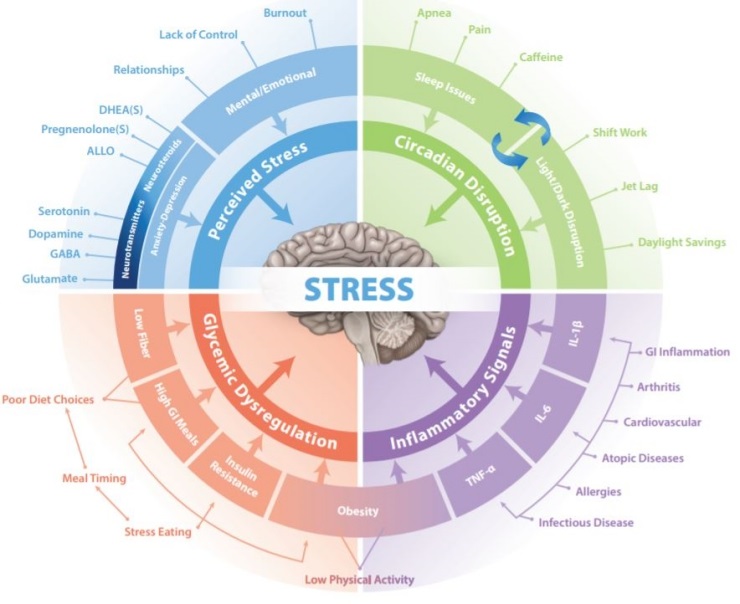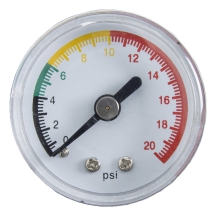Stress
Stress is your body's way of responding to a threat, real or perceived. The body's defenses respond with what’s known as the “fight-or-flight” reaction or the "stress response."
Stress makes the heart beat faster, blood vessels constrict elevating blood pressure, blood sugar goes up, muscles tense, the digestive and reproductive systems shut down and the vagus nerve withdraws. These are all good things when it’s a short-term response to a genuine stressor. But mechanisms that are protective in the short-term become damaging over the long term. The long term constant activation of the stress response system erodes resilience and depletes metabolic reserve resilience. In other words, chronic stress, so common in today’s modern age, is damaging our bodies.
Stress is multi-factored and individual. An event that is incredibly stressful for one individual could be completely stress free for another. There’s a saying, “if you can’t measure it, you can’t improve it” but that doesn’t apply to stress. There’s no number that can be monitored. It’s not as simple as measuring the “stress hormone” cortisol because it’s more nuanced than that. Frankly, the best measure is if you feel stressed, then you’re stressed, but even that’s imperfect because one can lead a very harmonious life and be still be affected by stressors such as a high glycemic diet or toxic exposure.
Managing stress isn’t as simple as just taking a deep breath. But don’t stress out, with knowledge and certain practices, stress can be managed.
Causes of Stress

Mental/emotional
- Work pressure
- Financial worry
- Family issues
- Marital issues/divorce
- Imprisonment
- Loss of loved one
- Abuse
- Neglect
- Moving
- Losing a job
- Raising children
- Perceived threat
- Caring for a loved one with difficult medical issue
Physical/Metabolic
- Chronic pain
- Disability
- Inflammation
- Chronic Illness diagnosis such as cancer, Multiple Sclerosis, Alzheimer’s etc.
- Over-exercise (produces high oxidative stress and prolonged elevated cortisol)
- Diet (glycemic control, food allergies/sensitivities) When insulin is chronically high, so is cortisol. If you are an adult and eat more than 30 grams of sugar a day, (one 12 ounce can of cola contains 39 grams of sugar) you are living in chronic stress (source: https://optimalterrainconsulting.com/the-book, Kindle location 4668 of 7162.). A poor diet can feed “bad bugs” in the gut (microbiome dysbiosis) thus deteriorating the gut–brain axis in regulating stress-related responses. Food sensitivities/allergies also place adrenal glands in chronic stress response.
- Prescription, over the counter, and recreational drugs
Toxic chemical exposure
- Pesticides
- Herbicides
- Preservatives
- Heavy Metals
- Cleaning Products
- Body Care Products
- Airborne Chemicals
- Cigarette Smoke
The Damaging Effects of Stress
Chronic stress leads to dysfunction of the HPA Axis (Hypothalamic Pituitary Adrenal axis), also commonly referred to as adrenal fatigue. The hypothalmus in the brain produces CRF (corticotropin releasing factor), that stimulates the pituitary gland to release ACTH (andrenocoticotropic hormone), the ACTH causes the adrenal glands to release cortisol and other stress related hormones.
The more stress the body experiences, the more the adrenals have to work to produce cortisol, the harder the adrenals have to work, the more fatigued they become, the less cortisol they can produce, resulting in even more stress and inflammation.
Stress effects every single cell in the body. Every cell in our body has the ability to produce and receive neuropeptides which neurons use to communicate with each other. Stress changes the neuropeptides our cells release. When the neuropeptides serotonin, dopamine, and relaxin are exchanged they have a healthy effect on the immune system, but when certain neuropeptides such as cortisol, epinephrine, and adrenaline are produced over an extended period of time, they damage cells and weaken the immune system.
Stress and ApoE4
At the 2016 Ancestral Health Symposium, Dr Dale Bredesen, noted neurodegeneration researcher presented a talk ApoE4 Mechanistics
In the presentation, Dr Bredesen explained that ApoE4 has been around for seven million years, it has served man literally since the dawn of mankind. He discussed how when our ancestors transitioned from tree dwellers to walking on the savannah new environmental insults were introduced: cuts to the feet, infections, fighting with others for food, going longer periods of time without food, fighting with predators, not cooking food, etc. An adaptive measure to increase survival in this new environment was inflammation. The ApoE4 pro-inflammatory state helped early man survive, it was a good thing. The ApoE3 allele showed up around 220,000 years ago, very “recently.” This was about the same time that man started using fire and cooking. ApoE3 is now the predominant genotype. The ApoE2 allele is a relative “newbie” showing up only around 80,000 years ago.
Dr Bredesen explained that one of the differences between ApoE4 and ApoE3 is that ApoE4 is RelA dominant. A RelA dominant state says, “I’m under attack, I want to set up most of my resources for inflammation, my NF-kappaB (NFκB) is going to be activated, I’m not worried about longevity, I’m not worried about recycling, and I’m not worried about oxidative phosphorylation, because I need rapid response to microbes.” This state was good for early man.
ApoE3 is SirT1 dominant. A SirT1 dominant state wants to put resources into recycling, into longevity, into oxidative phosphorylation, it’s anti-inflammatory. RelA and SirT1 are mutually antagonistic, you can’t have both, but you’re not locked in either, with certain strategies, an ApoE4 carrier can push over into a SirT1 dominant state, but stress is not a friend to an ApoE4 carrier trying to attain a SirT1 state. ApoE4s are particularly susceptible to Alzheimer’s disease, cardiovascular disease, and shortened longevity. Stress is not the sole driver in each of these conditions, but it does play an important role.
Stress and the Brain
As discussed above the stress chain of events in the HPA axis ends with pumping out high levels of cortisol. High levels of cortisol damages neurons, especially in the hippocampus contributing to cognitive, and in particular memory, decline.
Dr Bredesen emphasized reducing stress as one of the four pillars of his protocol: Diet, Exercise, Sleep, and Stress see Reduce stress
The early belief was that stress increases the cells that are dying in the brain, but according to Dr Daniela Kaufer from the Helen Wills Neuroscience Institute and the University of California, Berkeley, The Effects of Chronic Stress on the Brain stress itself does not kill brain cells, but stress makes those cells more vulnerable. Stress makes us more susceptible to the damage of other conditions that deteriorate brain heath. For example, if a person has Alzheimer’s disease, those cells are weaker, more likely to die, and stress can push them over the edge.
When it comes to neurons, we generate them throughout our life, even those in their 80s and 90s generate new neurons. But as we get older we generate fewer and fewer. Chronic stress depresses neuron generation. Depressing neuronal generation when your production is low to begin with isn’t a formula for success.
Stress also increases a number of risk factors that contribute to cognitive decline and Alzheimer’ disease, including increasing blood glucose levels, body fat storage which leads to insulin resistance, carbohydrate craving, leaky gut with its resulting inflammation, permeability of the blood brain barrier, calcium release, and hyperstimulation of neurons. Stress also attacks factors that protect against Alzheimer’s disease.
Stress and the Cardiovascular System
According to the American Institute of Stress , “the relationship between stress, heart disease and sudden death has been recognized since antiquity. The incidence of heart attacks and sudden death have been shown to increase significantly following the acute stress of natural disasters like hurricanes, earthquakes and tsunamis and as a consequence of any severe stressor that evokes “fight or flight’ responses. Coronary heart disease is also much more common in individuals subjected to chronic stress and recent research has focused on how to identify and prevent this growing problem, particularly with respect to job stress.”
Similarly, WebMD recognizes stress as bad for heart health, “If you're often stressed, and you don't have good ways to manage it, you are more likely to have heart disease, high blood pressure, chest pain, or irregular heartbeats.…Studies also link stress to changes in the way blood clots, which makes a heart attack more likely.”
Stress often also presents a downward spiral. Many responses to stress are unhealthy to the cardiovascular system: smoking, overeating, inadequate sleep, isolating from others, or not exercising. Those things only stress a person more and the response to stress is more smoking, overeating, inadequate sleep, etc. thus the downward health spiral.
Stress and Longevity
Telomeres are part of a human cell that that indicate how our cells are aging. According to T.A Sciences "What is a Telomere? short telomeres are connected to premature cellular aging. “Telomeres are the caps at the end of each strand of DNA that protect our chromosomes, like the plastic tips at the end of shoelaces. Without the coating, shoelaces become frayed until they can no longer do their job, just as without telomeres, DNA strands become damaged and our cells can’t do their job”
Elizabeth Blackborn, a Nobel laureate who is currently the President of the Salk Institute for Biological Studies and previously a biological researcher at the University of California, San Francisco, has studied telomeres extensively. Among her research, she looked at the telomeres of caregivers who are constantly faced with stress and discovered the telomeres were shorter in study participants who self-reported more stress. For a deeper dive, see The Telomere Effect
Stress also impacts immune system negatively in two ways: 1. By creating chronic inflammation that harms tissues 2. By suppressing immune cells needed to fight infection
Research has shown that those exposed to chronic social conflict experience high levels of stress and subsequent dysregulation of the immune system. This increases their vulnerability to infectious and autoimmune disease. Chronic stress can reduce our immune system’s ability to fight off antigens, the harmful invaders that can make us ill. This can make us more vulnerable to infections and disease.
This report Psychological Stress and the Human Immune System: A Meta-Analytic Study of 30 Years of Inquiry meta-analyzes more than 300 empirical articles describing a relationship between psychological stress and parameters of the immune system in human participants. From Conclusion:
- “The results of this meta-analysis support this assertion in one sense: Stressors with the temporal parameters of the fight-or-flight situations faced by humans’ evolutionary ancestors elicited potentially beneficial changes in the immune system. The more a stressor deviated from those parameters by becoming more chronic, however, the more components of the immune system were affected in a potentially detrimental way.”
Strategies to deal with Stress
coming soon


